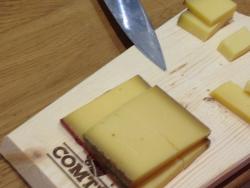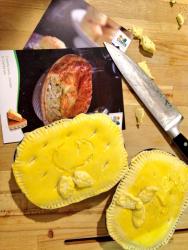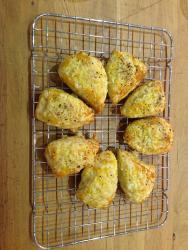As I sink my teeth into a nutty wedge of honey-yellow, 24-month-aged Comté, the back of my mouth seizing in sharp, tangy, saliva-inducing joy, there’s only one thought running through my head: there’s nothing quite like Comté when it comes to cheese.
This cheese tasting epiphany occurred in the shiny, pretty kitchen heaven that is Divertimenti cooking shop and kitchen on South Kensington road where I, and a host of foodie faces had gathered to see just how versatile Comté can be when it’s in the hands of a skilled chef like Laura Pope, who Comté had been working with to develop some cheese-filled recipes – hint, she was a bit more creative than me, who spent most of the evening shoving handfuls of the stuff into my mouth.
England might have a corner of the pedigree cheese market covered with heritage cheeses like Stilton and Cheddar, but if anyone gives us a run for our money in the prestige cheese stakes it’s France. Specialist dairy farmers have been cultivating Comté in the verdant Massif du Jura for more than 1,000 years and the cheese was granted the ultimate stamp of exclusive approval, – Appellation d’Origine Contrôlée (AOC) status – in 1958. All of this is unsurprising really when you consider that for Comté to even be considered true Comté it can only be made using the milk from protected Montbeliarde and French Simmental cows who have only been fed on natural feed in at least 2.5 acres of grazing pasture. Exacting perhaps, but it’s this precision and dedication to craftsmanship that produces such exceptional cheese.
Taste wise, all this attention to detail in the manufacture translates into a cheese with a truly mature, satisfying flavour that would be a welcome addition to any cheeseboard. It’s a taste that’s apparently made up of more than 80 recognisable flavours from animal and vegetable to fruity and roasted empyreumatic (think chicory, burnt onion and dark chocolate) that occurs when you bite into a slice of the stuff…if you don’t believe me, just have a look at Comté’s very own flavour wheel on their website.
But this evening was about more than trying to identify all 83 hints of flavour in a chunk of cheese; it was also about reproducing Laura Pope’s – a private chef, cookery tutor recipe developer and food writer – fantastically tasty and surprisingly easy recipes for getting the best out of Comté.
After a couple of flour-dusted, dough-covered hours, every member of the informal class had managed to produce some pretty spectacular chicken, tarragon and Comté pies and a dozen burnished Comté scones. Both of the recipes below are quick, easy and suitably Easter-ready to make, so grab a slab of this divine cheese and get cooking.
Comté scones with fig and vanilla jam
For the jam
750g ripe figs, stalks removed
2 vanilla pods, cut in half vertically and then in three lengthways
500g jam sugar
For the scones
250g plain flour
2 teaspoons baking powder
½ teaspoon salt
1 teaspoon caster sugar
60g unsalted butter, chilled and diced
100g Comté, grated
1 free range egg, beaten
100ml whole milk
1 free range egg yolk, beaten
To make your jam: turn the oven to 80 C (60 C fan oven) and put a saucer into the freezer. Wash your jars and dry, then put the jars on their sides into the oven for 10 minutes to sterilise them. Remove the jars and leave them to cool until they are warm.
Cut figs into eights and put them with the sugar and vanilla into a large saucepan over a low heat, stir and cook gently until the sugar has dissolved and the figs are mushy. Turn up the heat and let the jam bubble for about 10 minutes. Test if the jam is ready by dropping a blob on the saucer from the freezer. Leave for a few seconds then push very gently with the tip of your finger – if the surface of the jam wrinkles, it is ready. Remove pan from heat and let it stand for 10 minutes.
Stir to ensure the figs and vanilla pods are evenly distributed, then pour the hot jam into the warm jars (leave the vanilla pods in), immediately screwing a lid onto each jar – the heat will create a tight seal and help preserve the jam for 6-12 months.
To make your scones: preheat the oven to 200 C (180 C fan oven). Mix the flour and baking powder together with a balloon whisk (to break up any lumps and aerate the flour), mix in the salt and sugar and rub in the butter until it resembles breadcrumbs. Gently stir in most of the grated Comté (keep a little for the topping later). Beat the egg and milk together, add to the dry ingredients and mix everything together with a knife and then one hand to bring it all together in a dough. Leave it to rest for 10 minutes.
On a lightly floured surface, roll the dough to 3cm thick and cut into circles using a 4cm diameter cutter. Place the scones into a greased baking tray and rest for 10 minutes.
Brush the scones with beaten egg yolk and sprinkle with the remaining Comté.
Bake for about 12 to 15 minutes, then move to a wire rack to cool.
Best eaten freshly baked, buttered, with a slice of Comté and a dollop of jam.
Creamy leek, chicken and Comté pie (Serves 4)
1 small chicken, roasted
25g unsalted butter
1 leek, trimmed, washed, cut in half vertically then sliced finely
1 tablespoon plain flour
250ml whole milk
140ml double cream
2 tablespoons chopped tarragon
100g Comté cheese, grated
500g pack of all butter puff pastry
1 free range egg, beaten
Heat the oven to 220 C (200 C fan oven)
Tear the chicken flesh from the bone in large chunks and discard the skin and bones.
Heat the butter in a large pan and add the leek. Cook for five minutes or so, until softened and lightly coloured. Stir in the flour and cook for another minute, before gradually adding the milk.
Add the cream and simmer until the sauce thickens, then stir in the chicken, tarragon and Comté.
Roll out the pastry to the thickness of a £1 coin and cut four circles big enough to cover four small pie dishes (or you can do one big pie). Divide the mixture between the dishes and brush the rims with beaten egg.
Lift the pastry on to the pie(s), trimming off any excess. Press down and crimp the edges with a fork. Cut a couple of slits in the pastry to let the steam out and brush all over with the rest of the beaten egg.
Bake for 15 to 20 minutes (or 30 to 40 minutes if doing one big pie), until the pastry is crisp and golden brown.
Divertimenti run a range of cookery courses in their gorgeous test kitchen, from Indian Streetfood and Sourdough masterclasses to Knife Skills and Easter Entertaining. See all of their upcoming classes and information on how to book your place on a particular course on their website.
